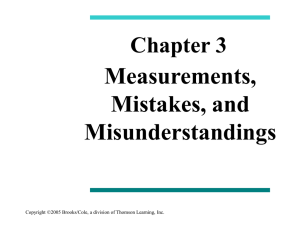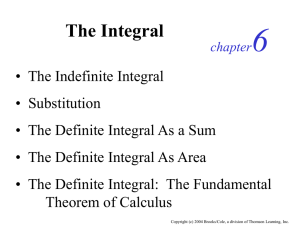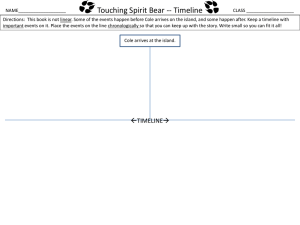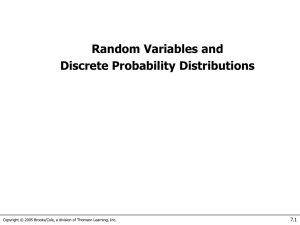Chapter 7 - Random Variables and Discrete Probability Distributions
advertisement
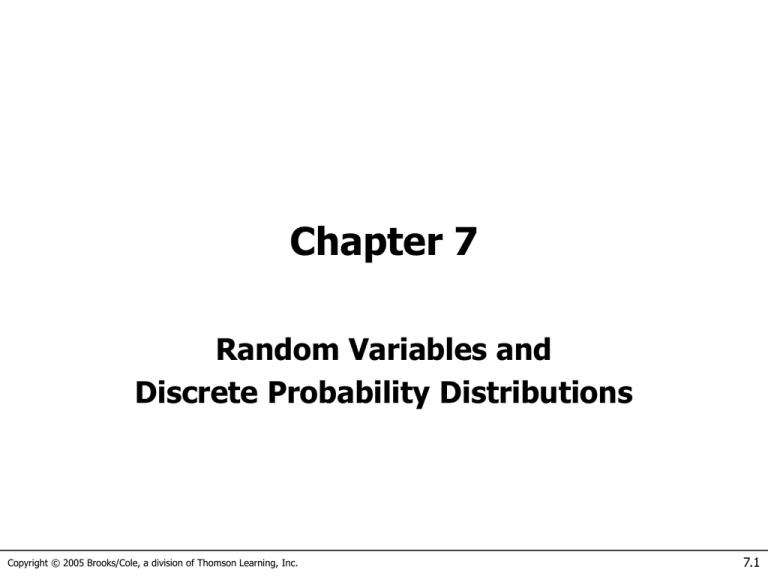
Chapter 7
Random Variables and
Discrete Probability Distributions
Copyright © 2005 Brooks/Cole, a division of Thomson Learning, Inc.
7.1
Random Variables…
A random variable is a function or rule that assigns a
number to each outcome of an experiment. Basically it is just
a symbol that represents the outcome of an experiment.
X = number of heads when the experiment is flipping a coin
20 times.
C = the daily change in a stock price.
R = the number of miles per gallon you get on your auto
during a family vacation.
Y = the amount of medication in a blood pressure pill.
V = the speed of an auto registered on a radar detector used
on I-20
Copyright © 2005 Brooks/Cole, a division of Thomson Learning, Inc.
7.2
Two Types of Random Variables…
Discrete Random Variable – usually count data [Number of]
* one that takes on a countable number of values – this means you can sit
down and list all possible outcomes without missing any, although it might take you
an infinite amount of time.
X = values on the roll of two dice: X has to be either 2, 3, 4, …, or 12.
Y = number of accidents on the UTA campus during a week: Y has to be 0, 1, 2, 3,
4, 5, 6, 7, 8, ……………”real big number”
Continuous Random Variable – usually measurement data [time, weight, distance,
etc]
* one that takes on an uncountable number of values – this means you can
never list all possible outcomes even if you had an infinite amount of time.
X = time it takes you to drive home from class: X > 0, might be 30.1 minutes
measured to the nearest tenth but in reality the actual time is
30.10000001…………………. minutes?)
Exercise: try to list all possible numbers between 0 and 1.
Copyright © 2005 Brooks/Cole, a division of Thomson Learning, Inc.
7.3
Probability Distributions…
A probability distribution (density function) is a table,
formula, or graph that describes the values of a random
variable and the probability associated with these values.
– Discrete Probability Distribution, (this chapter)
X = outcome of rolling one die
X
1 2 3 4 5 6
P(X) 1/6 1/6 1/6 1/6 1/6 1/6
– Continuous Probability Distribution (Chapter 8)
Copyright © 2005 Brooks/Cole, a division of Thomson Learning, Inc.
7.4
Discrete Probability Notation…
An upper-case letter will represent the name of the random
variable, usually X.
Its lower-case counterpart, x, will represent the value of the
random variable.
The probability that the random variable X will equal x is:
P(X = x) or more simply P(x)
X = number of heads in 10 flips of coin
P(X = 5) = P(5) = probability of 5 heads (x) in 10 flips
Copyright © 2005 Brooks/Cole, a division of Thomson Learning, Inc.
7.5
Discrete Probability Distributions…
Probabilities, P(x), associated with Discrete random
variables have the following properties.
X
1 2 3 4 5 6
P(X) 1/6 1/6 1/6 1/6 1/6 1/6
Copyright © 2005 Brooks/Cole, a division of Thomson Learning, Inc.
7.6
Developing Discrete Probability Distributions
Probability distributions can be estimated from relative
frequencies. Consider the discrete (countable) number of
televisions per household (X) from US survey data (Example
7.1)…
1,218 ÷ 101,501 = 0.012
e.g. P(X=4) = P(4) = 0.076 = 7.6%
Copyright © 2005 Brooks/Cole, a division of Thomson Learning, Inc.
7.7
Questions you might want answered
E.g. what is the probability there is at least one television but
no more than three in any given household?
“at least one television but no more than three”
P(1 ≤ X ≤ 3) = P(1) + P(2) + P(3) = .319 + .374 + .191 = .884
Copyright © 2005 Brooks/Cole, a division of Thomson Learning, Inc.
7.8
Developing Discrete Probability Distributions
Techniques covered in the Probability Chapter can be used to
develop probability distributions, for example, a mutual fund
sales person knows that there is 20% chance of closing a
sale on each call she makes.
What is the probability distribution of the number of sales
if she plans to call three customers?
Random Variable = X = # Sales Made in 3 Attempts
Let S denote probability of closing a sale P(S)=.20
Thus SC is not closing a sale, and P(SC)=.80
Seems reasonable to assume that sales are independent.
Copyright © 2005 Brooks/Cole, a division of Thomson Learning, Inc.
7.9
Sample Space: List of all possible outcomes
S1S2S3
SSSC
SSCS
SCSS
SSCSC
SCSSC
SCSCS
SCSCSC
: P(X = 3) = (.2)*(.2)*(.2) = 0.008
: P(X = 2) = (.2)*(.2)*(.8) = 0.032
: P(X = 2) = (.2)*(.8)*(.2) = 0.032
: P(X = 2) = (.8)*(.2)*(.2) = 0.032
: P(X = 1) = (.2)*(.8)*(.8) = 0.128
: P(X = 1) = (.8)*(.2)*(.8) = 0.128
: P(X = 1) = (.8)*(.8)*(.2) = 0.128
: P(X = 0) = (.8)*(.8)*(.8) = 0.512
: P(3) = .008
: P(2) = .032+.032+.032
(Additive Law)
: P(1) = .128+.128+.128
(Additive Law)
: P(0) = .512
NOTE: P(S1S2S3) = P(S1) * P(S2/S1) * P(S3/S1S2) “Mult. Rule”
= P(S1) * P(S2) * P(S3) “independent?”
= (.2)*(.2)*(.2) = 0.008
Copyright © 2005 Brooks/Cole, a division of Thomson Learning, Inc.
7.10
Another Approach: Tree Diagram
Developing a Probability Distribution…
Sales Call 1
Sales Call 2
Sales Call 3
(.2)(.2)(.8)= .032
P(S)=.2
P(S)=.2
P(SC)=.8
P(S)=.2
SSS
P(SC)=.8
P(S)=.2
S S SC
S SC S
P(SC)=.8
P(S)=.2
S SC SC
SC S S
P(SC)=.8
P(S)=.2
SC S SC
SC SC S
P(SC)=.8
SC SC SC
P(SC)=.8
P(S)=.2
P(SC)=.8
X
3
2
1
0
P(x)
.23 = .008
3(.032)=.096
3(.128)=.384
.83 = .512
P(X=2) is illustrated here…
Copyright © 2005 Brooks/Cole, a division of Thomson Learning, Inc.
7.11
Final Discrete Probability Distribution
X
0
1
2
3
P(x)
0.008
0.096
0.384
0.512
The mean of a discrete random variable is the weighted average of all
of its values. The weights are the probabilities. This parameter is also
called the expected value of X and is represented by E(X).
The variance is
The standard deviation is
Copyright © 2005 Brooks/Cole, a division of Thomson Learning, Inc.
7.12
Computing Mean, Variance, and Std. Dev. for Discrete Random Variable
X
P(x)
0
0.008
1
0.096
2
0.384
3
0.512
Mean = 0*(.008) + 1*(.096) + 2*(.384) + 3*(.512)
= 2.4
Variance = (0-2.4)2*(.008) + (1-2.4)2*(.096)
+ (2-2.4)2*(.384) + (3-2.4)2*(.512)
= .046 + .188 + .061 + .184 = .479
Std. Dev. = SQRT(.479) = .692
We are as smart as the goddess of statistics now, since we know the
true mean, variance, and standard deviation of the population.
Copyright © 2005 Brooks/Cole, a division of Thomson Learning, Inc.
7.13
Laws of Expected Value…”Useful to know”
1. E(c) = c
* The expected value of a constant (c) is just the value of the
constant.
2. E(X + c) = E(X) + c
* The expected value of a random variable plus a
constant is the expected value of the random variable
plus the constant
3. E(cX) = cE(X)
•The expected value of a constant times a random
variable is the constant times the expected value of the
random variable.
Copyright © 2005 Brooks/Cole, a division of Thomson Learning, Inc.
7.14
Laws of Expected Value…”Useful to know”
E(c1X1 + c2X2 + c3X3 + c4X4 + c5X5)
= c1E(X1) + c2E(X2) + c3E(X3) + c4E(X4) + c5E(X5)
Example: what is the expected mean weight of a surgical
pack containing 5 components [maybe we could weigh
the pack to determine if one of the components is
missing].
True when random variables are independent!!!
Copyright © 2005 Brooks/Cole, a division of Thomson Learning, Inc.
7.15
Laws of Variance…
1. V(c) = 0
• The variance of a constant (c) is zero.
2. V(X + c) = V(X)
• The variance of a random variable and a constant is just the
variance of the random variable.
3. V(cX) = c2V(X)
• The variance of a random variable and a constant coefficient is
the coefficient squared times the variance of the random variable.
Copyright © 2005 Brooks/Cole, a division of Thomson Learning, Inc.
7.16
Example: You weight all 30,000 students
Random Variable: X = students weight
Mean(X) = X-Bar = 160 lbs
Variance(X) = s2 = 900 lbs2
StdDev(X) = s = 30 lbs
*************************************
You now discover that the scales reported a student’s
weight 5 lbs too heavy. The student’s real weights (Y)
should have been Y = X – 5. What are the mean and
variance of the student’s REAL weights
Mean(Y) = Mean(X) – 5 = 160 – 5 = 155 lbs
Variance(Y) = Variance(X) = 900
StdDev(Y) = SQRT(900) = 30
Copyright © 2005 Brooks/Cole, a division of Thomson Learning, Inc.
7.17
Example: You measure the height of all 30,000 students
Random Variable: X = students height in “Feet”
Mean(X) = X-Bar = 5.8 feet
Variance(X) = s2 = 0.09 feet2
StdDev(X) = s = 0.3 feet
*************************************
You now discover that the President wanted to measure student’s
heights in “Inches” and not “Feet”. The student’s height in “Inches”
(Y) should have been Y = 12*X . What are the mean and variance of
the student’s heights in Inches?
Mean(Y) = 12*Mean(X) = 12*5.8 = 69.6 inches
Variance(Y) = 122*Variance(X) = 144*(.09) = 12.96
StdDev(Y) = SQRT(12.96) = 3.6
Copyright © 2005 Brooks/Cole, a division of Thomson Learning, Inc.
7.18
Laws…
We can derive laws of expected value and variance for the sum of two independent
random variables as follows…
E(X + Y) = E(X) + E(Y)
V(X + Y) = V(X) + V(Y)
**************************************************************
X = weight of right shoes: Mean(X) = .5 lbs and Var(X) = .0004
Y = weight of left shoes: Mean(Y) = .5 lbs and Var(Y) = .0004
**************************************************************
What is the mean and variance of a “Pair” of shoes. P = X +Y
E(P) = E(X + Y) = E(X) + E(Y) = .5 + .5 = 1.0
V(P) = V(X+Y) = V(X) + V(Y) = .0004 + .0004 = .0008
NOTE: WEIGHTS OF RIGHT AND LEFT SHOE INDEPENDENT
***************************************************************
? How could you determine the mean and variance of the weight of
an automobile after you make all the parts but before you
assemble the automobile
Copyright © 2005 Brooks/Cole, a division of Thomson Learning, Inc.
7.19
Binomial Distribution… 2 parameters [n and p]
The binomial distribution is the probability distribution that
results from doing a “binomial experiment”. Binomial
experiments have the following properties:
1. Fixed number of trials, represented as n.
2. Each trial has two possible outcomes, a “success” and a
“failure”.
3. P(success)=p (and thus: P(failure)=1–p), for all trials.
4. The trials are independent, which means that the
outcome of one trial does not affect the outcomes of any
other trials.
Copyright © 2005 Brooks/Cole, a division of Thomson Learning, Inc.
7.20
Success and Failure…
…are just labels for a binomial experiment, there is no value
judgment implied. You may define either one of the 2
possible outcomes as “Success”
For example a coin flip will result in either heads or tails. If
we define “heads” as success then necessarily “tails” is
considered a failure (inasmuch as we attempting to have the
coin lands heads up).
Other potential examples of binomial random variables:
– A firecracker pops or fails to pop
– A patient get an infection during an operation or does not get an
infection
Copyright © 2005 Brooks/Cole, a division of Thomson Learning, Inc.
7.21
Binomial Random Variable…
The random variable of a binomial experiment is defined as the
number of successes, X, in the n trials, where the probability of
success on a single trial is p.
E.g. flip a fair coin 10 times…
1) Fixed number of trials n=10
2) Each trial has two possible outcomes {heads (success), tails (failure)}
3) P(success)= 0.50; P(failure)=1–0.50 = 0.50
4) The trials are independent (i.e. the outcome of heads on the first flip will
have no impact on subsequent coin flips).
Hence flipping a coin ten times is a binomial experiment since all
conditions were met.
Copyright © 2005 Brooks/Cole, a division of Thomson Learning, Inc.
7.22
Binomial Distribution [formula]
The binomial random variable (# of successes in n trials) can
take on values 0, 1, 2, …, n. Thus, its a discrete random
variable.
Once we know a random variable is binomial, we can
calculate the probability associated with each value of the
random variable from the binomial distribution:
for x=0, 1, 2, …, n
x = # successes and n-x = # failures
Copyright © 2005 Brooks/Cole, a division of Thomson Learning, Inc.
7.23
Ways to Calculate Binomial Probabilities
1. Use the binomial distribution formula [not a good
approach unless n is fairly small]
2. Use the binomial tables at the back of most stat books
[not real good unless your specific value of “n” and “p”
happen to be included in the tables]
3. Approximate the binomial probabilities from some other
distributional form (normal) [no need to do this now that
we have access to various statistical software that will do
it for us]
4. Use Excel stat function “=BINOMDIST(x,n,p,false)”
which will return the individual probability. Replace
false with true and you will get the sum of the binomial
probabilities from 0 up to x.
Copyright © 2005 Brooks/Cole, a division of Thomson Learning, Inc.
7.24
Problem: Pat Statsdud…
Pat Statsdud failed to study for the next stat exam. Pat’s
exam strategy is to rely on luck for the next quiz. The quiz
consists of 10 multiple-choice questions (n=10). Each
question has five possible answers, only one of which is
correct (p=0.2). Pat plans to guess the answer to each
question.
What is the probability that Pat gets no answers correct?
P(X=0) = P(0) =
What is the probability that Pat gets two answers correct?
P(X=2) = P(2) =
Copyright © 2005 Brooks/Cole, a division of Thomson Learning, Inc.
7.25
Pat Statsdud…
n=10, and P(success) = .20
What is the probability that Pat gets no answers correct?
I.e. # success, x, = 0; hence we want to know P(x=0)
Pat has about an 11% chance of getting no answers correct
using the guessing strategy.
Copyright © 2005 Brooks/Cole, a division of Thomson Learning, Inc.
7.26
Pat Statsdud…
n=10, and P(success) = .20
What is the probability that Pat gets two answers correct?
I.e. # success, x, = 2; hence we want to know P(x=2)
Pat has about a 30% chance of getting exactly two answers
correct using the guessing strategy.
Copyright © 2005 Brooks/Cole, a division of Thomson Learning, Inc.
7.27
Cumulative Probability…
“Find the probability that Pat fails the quiz”
If a grade on the quiz is less than 50% (i.e. 5 questions
out of 10), that’s considered a failed quiz.
P(fail quiz) = P(X < 4) = P(0)+P(1)+P(2)+P(3)+P(4)
Called a cumulative probability, that is, P(X ≤ x)
Note: Calculating all these individual probabilities would be tedious
and time consuming, however, the Binomial tables at back of book
gives you the cumulative probabilities [n=10, p=0.2, x=4]
Copyright © 2005 Brooks/Cole, a division of Thomson Learning, Inc.
7.28
Pat Statsdud…
Calculate Individual Probabilities and Add Up!
P(X ≤ 4) = P(0) + P(1) + P(2) + P(3) + P(4)
We already know P(0) = .1074 and P(2) = .3020. Using the binomial
formula to calculate the others:
P(1) = .2684 , P(3) = .2013, and P(4) = .0881
Hense P(X ≤ 4) = .1074 + .2684 + … + .0881 = .9672
OR
Use binomial tables at back of book for n=10, p=0.2, and x=4 “Next
Slide”
Copyright © 2005 Brooks/Cole, a division of Thomson Learning, Inc.
7.29
Binomial Table…
“What is the probability that Pat fails the quiz”?
i.e. what is P(X ≤ 4), given P(success) = .20 and n=10 ?
P(X ≤ 4) = .967
Copyright © 2005 Brooks/Cole, a division of Thomson Learning, Inc.
7.30
Binomial Table…
“What is the probability that Pat gets no answers correct?”
i.e. what is P(X = 0), given P(success) = .20 and n=10 ?
P(X = 0) = P(X ≤ 0) = .107
Copyright © 2005 Brooks/Cole, a division of Thomson Learning, Inc.
7.31
Binomial Table…
“What is the probability that Pat gets two answers correct?”
i.e. what is P(X = 2), given P(success) = .20 and n=10 ?
P(X = 2) = P(X≤2) – P(X≤1) = .678 – .376 = .302
remember, the table shows cumulative probabilities…
Copyright © 2005 Brooks/Cole, a division of Thomson Learning, Inc.
7.32
=BINOMDIST() Excel Function…
There is a binomial distribution function in Excel that can
also be used to calculate these probabilities. For example:
What is the probability that Pat gets two answers correct?
# successes
# trials
P(success)
True: cumulative prob.
False: individual prob.
P(X=2)=.3020
Copyright © 2005 Brooks/Cole, a division of Thomson Learning, Inc.
7.33
=BINOMDIST() Excel Function…
There is a binomial distribution function in Excel that can
also be used to calculate these probabilities. For example:
What is the probability that Pat fails the quiz?
# successes
# trials
P(success)
cumulative
(i.e. P(X≤x)?)
P(X≤4)=.9672
Copyright © 2005 Brooks/Cole, a division of Thomson Learning, Inc.
7.34
Binomial Distribution…
As you might expect, statisticians have determined formulas
for the mean, variance, and standard deviation of a binomial
random variable. They are:
Previous example: n=10, p=0.2
μ = n*p = 10*0.2 = 2
σ2 = n*p*(1-p) = 10*0.2*0.8= 1.6
σ = SQRT(1.6) = 1.26
Copyright © 2005 Brooks/Cole, a division of Thomson Learning, Inc.
7.35
Poisson Distribution… 1 parameter [μ]
Named for Simeon Poisson, the Poisson distribution is a
discrete probability distribution and refers to the number of
events (a.k.a. successes) within a specific time period or
region of space. For example:
• The number of cars arriving at a service station in 1 hour. (The
interval of time is 1 hour.)
• The number of flaws in a bolt of cloth. (The specific region is a
bolt of cloth.)
• The number of accidents in 1 day on a particular stretch of
highway. (The interval is defined by both time, 1 day, and space,
the particular stretch of highway.)
Copyright © 2005 Brooks/Cole, a division of Thomson Learning, Inc.
7.36
Poisson Probability Distribution…
The probability that a Poisson random variable assumes a
value of x is given by:
Note: μ is the only parameter [tell me μ and I can calculate
the probabilities]
and e is the natural logarithm base.
FYI:
Copyright © 2005 Brooks/Cole, a division of Thomson Learning, Inc.
7.37
Example 7.12…
The number of typographical errors in new editions of
textbooks varies considerably from book to book. After some
analysis he concludes that the number of errors is Poisson
distributed with a mean of 1.5 typos per 100 pages. The
instructor randomly selects 100 pages of a new book. What
is the probability that there are no typos?
That is, what is P(X=0) given that
= 1.5?
“There is about a 22% chance of finding zero errors”
Copyright © 2005 Brooks/Cole, a division of Thomson Learning, Inc.
7.38
Poisson Distribution…
As mentioned on the Poisson experiment slide:
The probability of a success is proportional to the size of
the interval
Thus, knowing an error rate of 1.5 typos per 100 pages, we
can determine a mean value for a 400 page book as:
=1.5(4) = 6 typos / 400 pages.
Copyright © 2005 Brooks/Cole, a division of Thomson Learning, Inc.
7.39
Example 7.13…
For a 400 page book, what is the probability that there are
no typos?
P(X=0) =
“there is a very small chance there are no typos”
Copyright © 2005 Brooks/Cole, a division of Thomson Learning, Inc.
7.40
Example 7.13…
For a 400 page book, what is the probability that there are
five or less typos?
P(X≤5) = P(0) + P(1) + … + P(5)
This is rather tedious to solve manually. A better alternative
is to refer to Table 2 in Appendix B…
…k=5,
=6, and P(X ≤ k) = .446
“there is about a 45% chance there are 5 or less typos”
Copyright © 2005 Brooks/Cole, a division of Thomson Learning, Inc.
7.41
Example 7.13…
…Excel is an even better alternative:
Copyright © 2005 Brooks/Cole, a division of Thomson Learning, Inc.
7.42
Poisson Practice
The number of infections [X] in a hospital each week has
been shown to follow a poisson distribution with mean 3.0
infections per week. Calculate the following probabilities.
•P(X = 0) =
•P(X < 4) =
•P(X > 9) =
•If you found 9 infections next week, what would you say??
Copyright © 2005 Brooks/Cole, a division of Thomson Learning, Inc.
7.43
